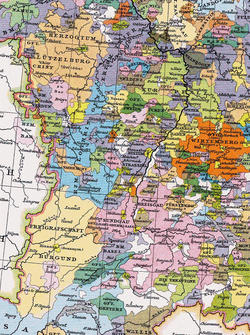
Back دوقية لورين Arabic Латарынгія (герцагства) Byelorussian Херцогство Лотарингия Bulgarian Dugelezh Loren Breton Ducat de Lorena Catalan Lotrinské vévodství Czech Hertugdømmet Øvre-Lorraine Danish Herzogtum Lothringen German Δουκάτο της Λωρραίνης Greek Duklando Loreno Esperanto
Duchy of Lorraine | |||||||||
|---|---|---|---|---|---|---|---|---|---|
| 959–1766 | |||||||||
Coat of arms
(1300–1766) | |||||||||
| Motto: Un pour tout/Une pour toutes (French)[1] "One for everything"/"One for all" | |||||||||
 Duchy of Lorraine (blue) within the Holy Roman Empire (c. 1400) | |||||||||
| Status | Part of East Francia (959–962) State of the Holy Roman Empire (962–1766) | ||||||||
| Capital | Nancy | ||||||||
| Religion | Roman Catholicism | ||||||||
| Demonym(s) | Lorrainian | ||||||||
| Government | Duchy | ||||||||
| Duke | |||||||||
• 959–978 | Frederick I of Bar | ||||||||
• 1737–1766 | Stanisław Leszczyński | ||||||||
| History | |||||||||
• Lotharingia divided | 959 | ||||||||
| 1500 | |||||||||
• French invasion and occupation of the Duchy of Lorraine | 1643 | ||||||||
• French invasion and subsequent occupation for 30 years | 1670 | ||||||||
• French invasion during War of the Spanish Succession | 1702 | ||||||||
• Annexed by France | 1766 | ||||||||
| |||||||||
| Today part of | |||||||||
| Part of a series on |
| Lorraine |
|---|
 |
The Duchy of Lorraine (French: Lorraine [lɔʁɛn] ⓘ; German: Lothringen [ˈloːtʁɪŋən] ⓘ), originally Upper Lorraine, was a duchy now included in the larger present-day region of Lorraine in northeastern France. Its capital was Nancy.
It was founded in 959 following the division of Lotharingia into two separate duchies: Upper and Lower Lorraine, the westernmost parts of the Holy Roman Empire. The Lower duchy was quickly dismantled, while Upper Lorraine came to be known as simply the Duchy of Lorraine. The Duchy of Lorraine was coveted and briefly occupied by the dukes of Burgundy and the kings of France, but was ruled by the dukes of the House of Lorraine after 1473.
In 1737, the duchy was given to Stanisław Leszczyński, the former king of Poland, who had lost his throne as a result of the War of the Polish Succession, with the understanding that it would fall to the French crown on his death. When Stanisław died on 23 February 1766, Lorraine was annexed by France and reorganized as the province of Lorraine and Barrois.
- ^ Augustin Calmet (1745). "Sur les sceaux, armoiries, couleurs, devises, cris de guerre, titres des Ducs de Lorraine". Histoire de Lorraine. Leseur..

